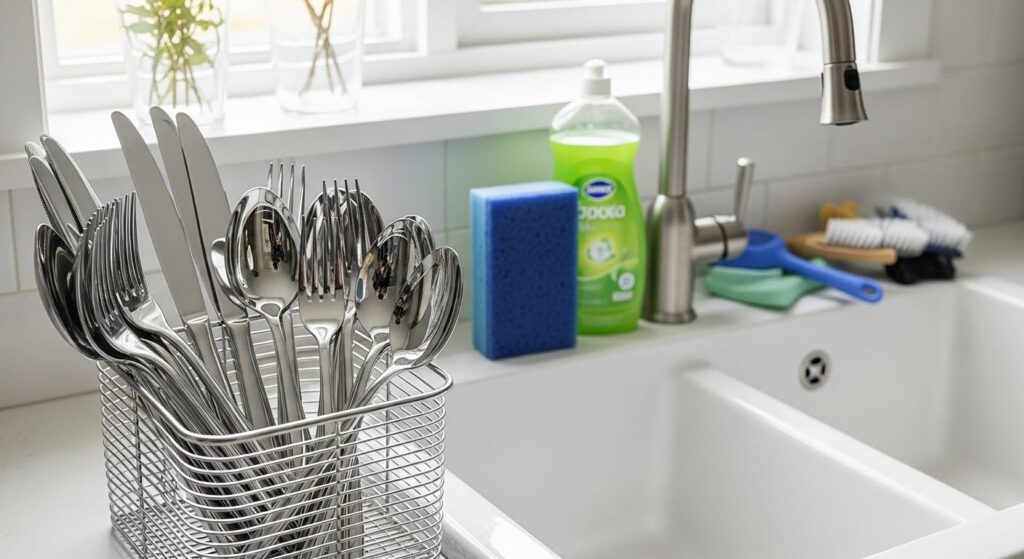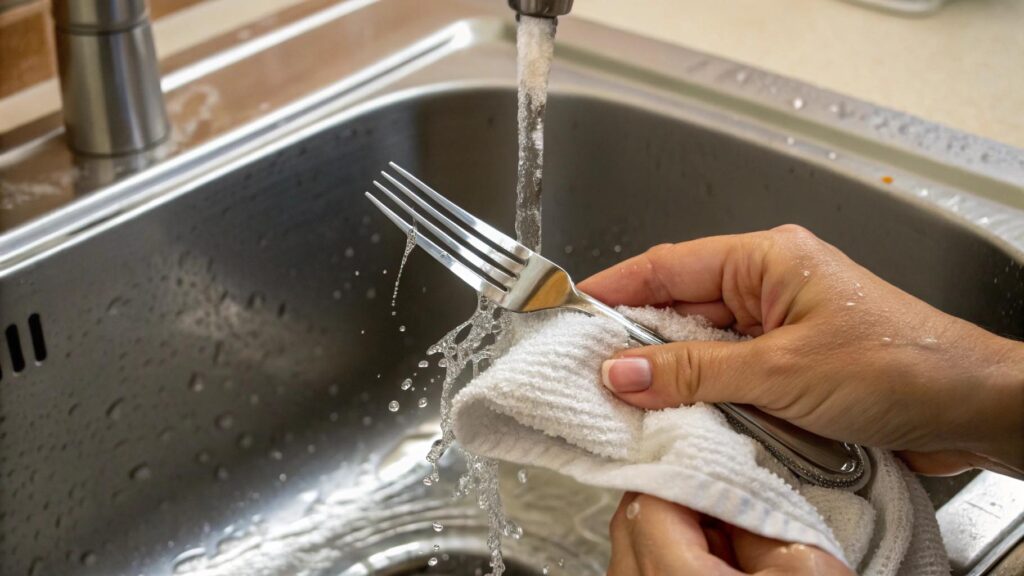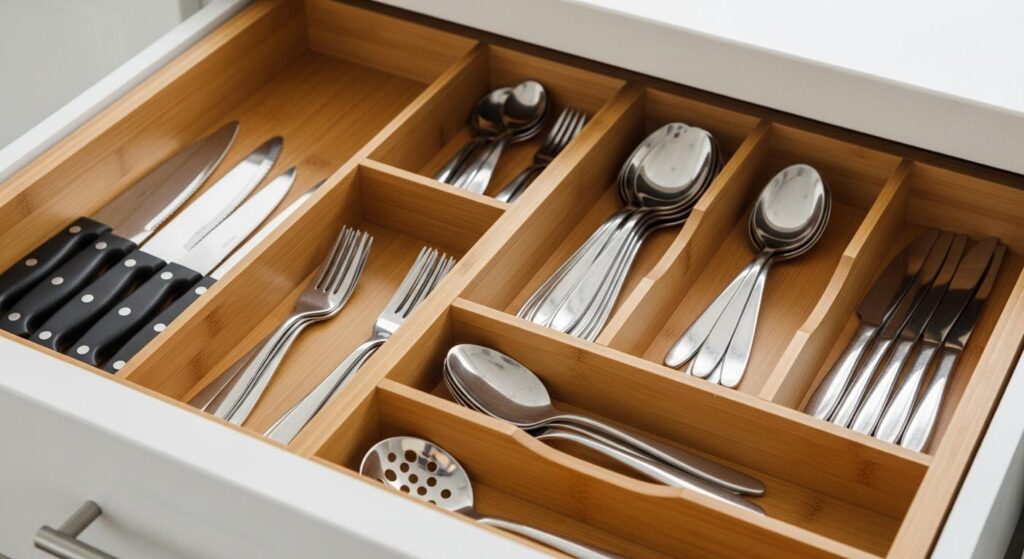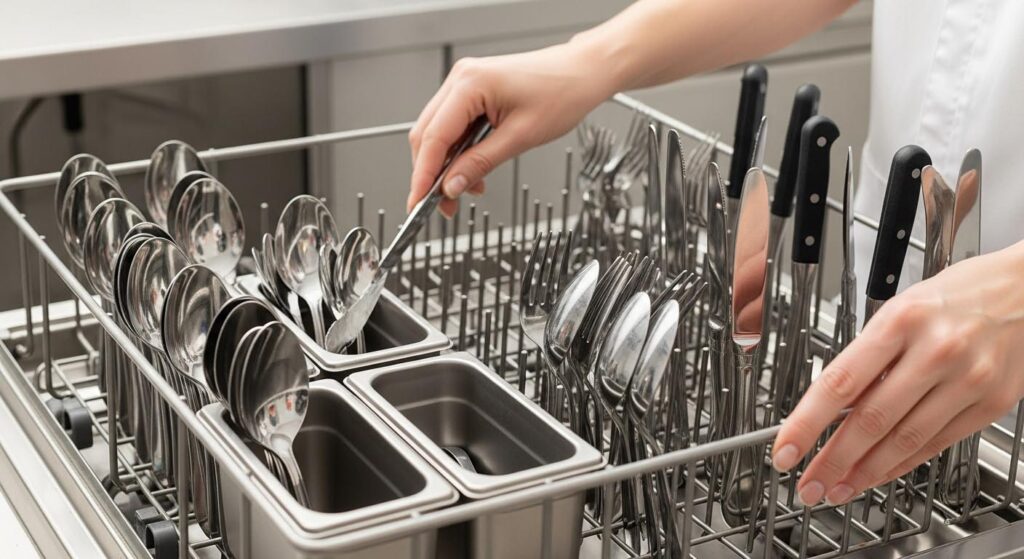How to clean stainless steel flatware?
Your beautiful stainless steel flatware gets water spots and looks dull. You worry it's ruined or low quality. But simple, correct cleaning keeps it looking new forever.
The best way is to wash it soon after use with a soft cloth and mild soap. Rinse with hot water and dry immediately to prevent spots. For stubborn stains, use vinegar or a baking soda paste. Avoid harsh scrubbers.

In my factory, we take immense pride in the grade of steel we use and the finish we apply to our flatware. But all that work can be undone with poor care. I've had conversations with professional buyers like Jacky, who works for a big US brand, about this very topic. He's seen customers return perfectly good cutlery, claiming it was "defective," when the problem was simply improper cleaning. Knowing how to care for your steel is just as important as choosing the right set in the first place.
What is the best way to clean stainless steel flatware?
You put your flatware in the dishwasher, and it comes out spotted. Hand-washing doesn't seem much better. There must be a secret to getting that perfect, brand-new finish back.
For daily cleaning, hand-washing with mild soap and immediate drying is best. In a dishwasher, use a good rinse aid, avoid overcrowding, and remove and dry the flatware as soon as the cycle ends to prevent spotting.

The ideal method is often the simplest. By hand, wash your flatware with a soft cloth or sponge and a gentle dish soap. Harsh scrubbers like steel wool will scratch the finish. Rinse with very hot water, as this helps it dry faster and with fewer spots. The most critical step is to dry it immediately with a soft towel. Don't let it air dry, as this is what causes mineral spots from the water.
In a dishwasher, place items in the cutlery basket without letting them "spoon" or nest together. This ensures water can clean all surfaces. Use a rinse aid to help water sheet off the metal. When the cycle is over, open the door to let steam escape and dry the pieces as soon as possible.
How to Fix Common Problems
Even with good care, issues can pop up. Here's what I tell my clients:
- Water Spots: If you air-dried them and see mineral spots, just wipe the piece with a soft cloth dampened with white vinegar. Rinse and dry again.
- Rainbow Stains: This bluish tint is from high heat and detergents. It's not permanent. Wipe it with a cloth and white vinegar, or use a non-abrasive cleaner like Bar Keepers Friend.
- Rust Spots: Yes, even 18/10 steel can get a rust spot if left wet or in contact with other metals. Make a paste of baking soda and water and gently rub the spot. It should come right off.
How often do utensils need to be washed, rinsed, and sanitized?
After a big meal, it's easy to let used utensils pile up. But this allows food acids to damage the steel and bacteria to grow. The rule is simple and non-negotiable.
Utensils must be thoroughly washed, rinsed, and sanitized after every single use. In a commercial setting, this is a strict food safety rule. At home, cleaning immediately after the meal prevents damage and protects your family's health.

The "why" behind this rule is twofold: preserving the flatware and ensuring safety. Firstly, certain foods contain acids (like tomatoes, lemons, or vinegar) or salts that can cause pitting or staining if left on the steel for hours. This is chemical damage. Washing promptlyneutralizes these foods and protects the metal's finish. Secondly, from a health perspective, used utensils are a breeding ground for bacteria. The process of "wash, rinse, sanitize" is a core principle of food safety. In a home kitchen, washing with hot, soapy water and rinsing with clean, hot water effectively does this job. In a commercial setting, it's a more formal process. They either use a high-temperature dishwasher where the final rinse reaches sanitizing temperatures (above 180°F / 82°C) or a three-compartment sink system with a chemical sanitizer in the final step. There is no grace period; once a utensil is used, it's considered dirty and must be fully cleaned before its next use.
How should flatware that has been cleaned and sanitized be stored?
You spend time getting your flatware perfectly clean. But tossing it in a drawer can cause scratches and re-contamination. Proper storage is the simple final step to protect your investment.
Store cleaned flatware in a dry, clean drawer with a utensil organizer to prevent scratching. In restaurants, they should be stored with handles up in clean containers to avoid touching the food-contact surfaces when grabbing them.

How you store your flatware is the final step in proper care. For home use, a drawer organizer is your best friend. It prevents the pieces from knocking against each other, which is the primary cause of the fine scratches that dull a finish over time. The drawer and the organizer should be clean and completely dry. Any residual moisture can lead to water spots or, in rare cases, rust.
For a restaurant, storage is a critical part of the health code. After washing and sanitizing, flatware is placed in clean, sanitary cylinders or bins. The universal best practice is to store them with the handles facing up. This ensures that when a server grabs a fork or spoon, they are only touching the handle, not the tines or bowl that the customer will eat with. This prevents the transfer of germs from hands to the food-contact surface. Proper storage protects both the flatware and the customer. And a special note: never wash or store stainless steel and silver items together. A chemical reaction can occur that damages both metals.
How to wash silverware in a restaurant?
Washing cutlery for a few people is easy. Washing for hundreds per hour is a major operational challenge. A single mistake can lead to health code issues or costly replacement of inventory.
Restaurants use high-temperature commercial dishwashers. Flatware is often pre-soaked to loosen food, then placed in special racks to ensure full water exposure. A rinse aid is essential for a spot-free finish, followed by immediate storage in sanitary containers.

The restaurant process is a masterclass in efficiency and safety. Here's how it works from start to finish. First, dirty flatware is scraped to remove large food debris and then often placed in a pre-soak solution. This loosens tough, cooked-on food. Next, it's loaded into perforated, cylindrical racks. It’s important not to pack them too tightly and to mix utensils to prevent them from nesting. The racks go into a powerful, high-temperature commercial dishwasher. The final rinse cycle uses water heated to at least 180°F (82°C) to sanitize the items. A chemical rinse aid is injected into this final rinse, which makes water run off the flatware in sheets, preventing spots. Once the cycle is done, the hot racks are removed to air dry, which happens very quickly due to the residual heat. Staff are trained to handle the clean, dry cutlery only by the handles as they sort it into sanitary storage bins. This system ensures every single piece is clean, sanitized, and ready for the next customer.
Conclusion
Proper cleaning is simple: wash promptly, dry immediately, and store carefully. This easy routine will keep your stainless steel flatware looking beautiful and safe for a lifetime of use.
